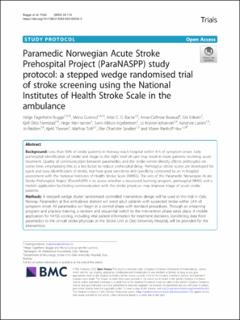| dc.contributor.author | Bugge, Helge Fagerheim | |
| dc.contributor.author | Guterud, Mona | |
| dc.contributor.author | Bache, Kristi Cecilie Grønvold | |
| dc.contributor.author | Braarud, Anne-Cathrine | |
| dc.contributor.author | Eriksen, Erik | |
| dc.contributor.author | Fremstad, Kjell Otto | |
| dc.contributor.author | Ihle-Hansen, Hege | |
| dc.contributor.author | Ingebretsen, Svein Håkon | |
| dc.contributor.author | Kramer-Johansen, Jo | |
| dc.contributor.author | Larsen, Karianne | |
| dc.contributor.author | Røislien, Jo | |
| dc.contributor.author | Thorsen, Kjetil | |
| dc.contributor.author | Toft, Mathias | |
| dc.contributor.author | Sandset, Else Charlotte | |
| dc.contributor.author | Hov, Maren Ranhoff | |
| dc.coverage.spatial | Norway | en_US |
| dc.date.accessioned | 2022-09-27T11:55:45Z | |
| dc.date.available | 2022-09-27T11:55:45Z | |
| dc.date.created | 2022-05-20T08:18:33Z | |
| dc.date.issued | 2022-02-04 | |
| dc.identifier.citation | Trials. 2022, 23 (1), . | en_US |
| dc.identifier.issn | 1745-6215 | |
| dc.identifier.uri | https://hdl.handle.net/11250/3021778 | |
| dc.description.abstract | Background: Less than 50% of stroke patients in Norway reach hospital within 4 h of symptom onset. Early prehospital identification of stroke and triage to the right level of care may result in more patients receiving acute treatment. Quality of communication between paramedics and the stroke centre directly affects prehospital on-scene time, emphasising this as a key factor to reduce prehospital delay. Prehospital stroke scales are developed for quick and easy identification of stroke, but have poor sensitivity and specificity compared to an in-hospital assessment with the National Institutes of Health Stroke Scale (NIHSS). The aim of the Paramedic Norwegian Acute Stroke Prehospital Project (ParaNASPP) is to assess whether a structured learning program, prehospital NIHSS and a mobile application facilitating communication with the stroke physician may improve triage of acute stroke patients.
Methods: A stepped wedge cluster randomised controlled intervention design will be used in this trial in Oslo, Norway. Paramedics at five ambulance stations will enrol adult patients with suspected stroke within 24 h of symptom onset. All paramedics will begin in a control phase with standard procedures. Through an e-learning program and practical training, a random and sequential switch to the intervention phase takes place. A mobile application for NIHSS scoring, including vital patient information for treatment decisions, transferring data from paramedics to the on-call stroke physician at the Stroke Unit at Oslo University Hospital, will be provided for the intervention. The primary outcome measure is positive predictive value (PPV) for prehospital identification of patients with acute stroke defined as the proportion of patients accepted for stroke evaluation and discharged with a final stroke diagnosis. One thousand three hundred patients provide a 50% surplus to the 808 patients needed for 80% power to detect a 10% increase in PPV.
Discussion: Structured and digital communication using a common scale like NIHSS may result in increased probability for better identification of stroke patients and less stroke mimics delivered to a stroke team for acute diagnostics and treatment in our population. | en_US |
| dc.description.sponsorship | The study is funded by the Norwegian Air Ambulance Foundation and Oslo University Hospital, Norway. | en_US |
| dc.language.iso | eng | en_US |
| dc.publisher | BMC | en_US |
| dc.relation.ispartofseries | Trials;23, Article number: 113 (2022) | |
| dc.rights | Navngivelse 4.0 Internasjonal | * |
| dc.rights.uri | http://creativecommons.org/licenses/by/4.0/deed.no | * |
| dc.subject | Paramedics | en_US |
| dc.subject | Ambulances | en_US |
| dc.subject | Strokes | en_US |
| dc.subject | National Institutes of Health Stroke Scale | en_US |
| dc.subject | Triages | en_US |
| dc.subject | Positive predictive values | en_US |
| dc.subject | Mobile applications | en_US |
| dc.title | Paramedic Norwegian Acute Stroke Prehospital Project (ParaNASPP) study protocol: a stepped wedge randomised trial of stroke screening using the National Institutes of Health Stroke Scale in the ambulance | en_US |
| dc.type | Peer reviewed | en_US |
| dc.type | Journal article | en_US |
| dc.description.version | publishedVersion | en_US |
| dc.rights.holder | © The Author(s). 2022 | en_US |
| cristin.ispublished | true | |
| cristin.fulltext | original | |
| cristin.qualitycode | 1 | |
| dc.identifier.doi | https://doi.org/10.1186/s13063-022-06006-4 | |
| dc.identifier.cristin | 2025813 | |
| dc.source.journal | Trials | en_US |
| dc.source.volume | 23 | en_US |
| dc.source.issue | 1 | en_US |
| dc.source.pagenumber | 1-11 | en_US |

